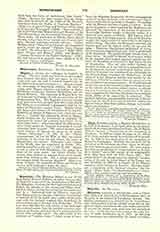

Megarians. —The Megarian School is one of the imperfectly Socratic Schools, so called because they developed in a one-sided way the doctrines of Socrates. The Megarians, of whom the chief representatives were Euclid, the founder of the school, and Stilpo, flourished at Athens, during the first half of the fourth century B.C. Borrowing from the Eleatics, especially from Parmenides, the doctrine that there is no change or multiplicity in the world, they combined this principle with the Socratic teaching that knowledge by means of concepts is the only true knowledge. It follows from this that the only reality is the unchangeable essential nature, that the world of our sense experience is an illusion, and that there is nothing possible except what actually exists. The affirmation of the existence of “bodiless forms”, which seems to have been the Megarian designation for the unchangeable essential natures of things, is the school’s most important contribution to speculative thought. Its analogy with the Platonic doctrine of ideas is evident. In the practical portion of their teaching the Megarians emphasized the supremacy of the notion of goodness. Knowledge, Socrates taught, is the only virtue; it is identical with moral excellence. The highest object of knowledge is the highest good. But, as the Eleatics taught, the highest object of knowledge is the highest reality, being. Therefore, the Megarians conclude, the highest good and the highest reality are one and the same. Whatever Parmenides predicated of being, namely oneness, immutability, etc., may be predicated of the good also. The good is insight, reason, God; it alone exists. In order to defend these tenets, which to the popular mind seemed not only untrue but absurd, the Megarians developed to a high degree the art of disputation. This art (the eristic method, or method of strife, as it was called in contradistinction to the heuristic method, or method of finding, advocated by Socrates), was introduced into philosophy by the Eleatic, Zeno, surnamed the Dialectican. It was adopted in the Megarian School, and carried by the followers of Euclid to a point where it ceased to serve any useful or even serious purpose. To Euclid himself we owe the use of the method of argumentation known as the reductio ad absurdum, which consists in attacking, not the premises, but the conclusion, of the opponent’s argument and showing the absurd consequences which follow if his contention is admitted. This method, however, was germinally contained in Zeno’s procedure by which, in a series of specious fallacies he had striven to show that motion, change, and multiplicity are illusions.
WILLIAM TURNER

